 | Note: Large images and tables on this page may necessitate printing in landscape mode.
Copyright 2007 The McGraw-Hill Companies. All rights reserved.
Clinician's Pocket Reference > Chapter 17. Suturing Techniques and Wound Care >
Wound Healing The process of wound healing is generally divided into four stages: inflammation, fibroblast proliferation, contraction, and remodeling. There are three types of wound healing: - First intention. The wound is closed by routine primary suturing, stapling, or gluing. Epithelialization occurs in 24 48 h.
- Secondary intention. The wound is not closed by suturing, stapling, or gluing but closes by spontaneous contraction and epithelialization at a rate of 1 mm/d). Most often used for wounds that are infected and packed open.
- Third intention (also called delayed primary closure). The wound is left open for a time and then sutured at a later date. Often used with grossly contaminated wounds.
|
Vacuum-Assisted Closure Used for healing both acute and chronic wounds. Continuous negative pressure is distributed over the wound surface. The system consists of a soft sponge cut to fit and occupy the volume of the wound, a plastic tube imbedded in the center of the sponge and extending out of the wound to a controlled suction pump, and a gas- and fluid-impermeable plastic outer film that adheres to the back of the sponge and the surrounding normal skin. Vacuum-assisted closure allows "active" removal of extracellular debris (exudate). Soft-tissue defects heal faster when subatmospheric pressure is applied. Used for wounds resulting from pressure, trauma, infection, IV extravasation, A V insufficiency, and skin grafting. |
Suture Materials (See Tables 17 1 And 17 2) Table 17 1 Common Absorbable Suture Materials
|
| | Suture (Brand Names) | Description | Tensile Strengtha
| Absorbed | Common Uses |
|---|
| Fast catgut | Twisted/fast absorption | 3 5 d | 30 d | Facial lacerations in children | | Plain catgut | Twisted/rapidly absorbable | 7 10 d | 70 d | Vessel ligation, subcutaneous tissues | | Chromic catgut | Twisted/absorbable | 10 14 d | 90 d | Mucosa | | Polyglycolic acid (Dexon) | Braided/absorbable | 14 21 d | 60 90 d | GI, subcutaneous tissues | | Polyglactin 910 (Vicryl Rapide) | Braided/absorbable | 5 d | 42 d | Skin repair needing rapid absorption | | Polyglactin 910 (Vicryl) | Braided/absorbable | 21 d | 56 70 d | Bowel, deep tissue | | Poliglecaprone 25 (Monocryl) | Monofilament/absorbable | 7 14 d | 91 119 d | Skin, bowel | | Polydioxanone (PDS) | Monofilament/absorbable | 28 d | 6 mo | Fascia, GI | | Polyglyconate (Maxon) | Braided/absorbable | 28 d | 6 mo | GI, muscle, fascia | | Panacryl | Braided/absorbable | >6 mo | >24 mo | Fascia, tendons |
|
aWhen suture loses approximately 50% strength. |
Table 17 2 Common Nonabsorbable Suture Materials
|
| | Suture (Brand Names) | Description | Common Uses |
|---|
| Polytetrafluoroethylene (PTFE) (Gore-Tex) | Monofilament | Vascular grafts, hernia, valve repair | | Nylon (Dermalon, Ethilon) | Monofilament | Skin, drains | | Nylon (Nurolon) | Braided | Tendon repair | | Polyester (Ethibond, Tycron) | Braided | Cardiac, tendon | | Polypropylene (Prolene) | Monofilament | Vessel, fascia, skin | | Silk | Braided | GI, vessel ligation, drains | | Stainless steel | Monofilament | Fascia, sternum |
|
|
Suture materials can be broadly defined as absorbable and nonabsorbable. Absorbable sutures can be thought of as temporary and include plain catgut, chromic catgut, and synthetic materials such as polyglactin 910 (Vicryl), polyglycolic acid (Dexon), and polyglecaprone (Monocryl). Left inside the body, these materials are resorbed after a variable period. Polydioxanone (PDS) is a long-lasting absorbable suture. Nonabsorbable sutures can be thought of as "permanent" unless they are removed; these materials include silk, stainless steel wire, polypropylene (Prolene), and nylon. The size of a suture is defined by the number of zeros. The more zeros in the number, the smaller is the suture. For example, 5-0 suture (00000) is much smaller than 2-0 (00) suture. Most sutures come prepackaged and mounted on needles ("swaged on"). Cutting needles are used for tough tissues such as skin, and tapered needles are used for more delicate tissues such as intestine. The most common needle for skin closure is the 3/8-circle cutting needle. |
Suturing Procedure The following guidelines cover repair of lacerations in the emergency setting. Similar principles hold true for closure of wounds in the OR. The choice of suture material is based on many factors, including location, extent of the laceration, strength of the tissues, and preference of the physician. - Face: 5-0 or 6-0 nylon or polypropylene when appearance is important
- Scalp: 3-0 nylon or polypropylene
- Trunk and extremities: 4-0 or 5-0 nylon or polypropylene
- Use 3-0 and 4-0 absorbable sutures such as Dexon or Vicryl to approximate deep tissues. Close skin with interrupted sutures placed with good approximation and minimal tension or with a running subcuticular suture. Use tissue adhesives selectively (see Tissue Adhesives). Suture patterns are discussed in the next section. Suture marks ("tracks") are the result of excessive tension on the tissue or leaving the sutures in too long. In most cases the length of time and the technique used are more important in determining the final result than is the type of suture used.
- 1. Remove all foreign materials and devitalized tissues by sharp excision (debridement). Clean the wound with plain saline solution (avoid antiseptic solutions for wound cleansing because they can be toxic to viable cells). A useful technique involves irrigation with at least 200 mL of saline through a 35-mL syringe and a 19-gauge needle. Anesthesia may be necessary before any of these steps. If all the debris is not removed, traumatic "tattooing" of the skin can result.
- 2. Obtain a surgical consultation before suturing infected or contaminated wounds, lacerations more than 6 12 h old (24 h on the face), missile wounds, and human or animal bites.
- 3. Anesthetize the wound by infiltrating it with an agent such as 0.5% or 1% lidocaine (Xylocaine). The maximum safe dose is 4.5 mg/kg (about 28 mL of a 1% solution in an adult). Lidocaine and other local anesthetic agents are available with epinephrine (1:100,000 or 1:200,000) added to produce local vasoconstriction that prolongs the anesthetic effect and helps decrease systemic side effects and bleeding. Use epinephrine with caution, particularly in treatment of patients with a history of hypertension, and do not used epinephrine on the fingers, toes, or penis. One milliliter of 1:10 NaHCO3 can be mixed with 9 mL of lidocaine to help minimize the discomfort of the injection. Commonly used local anesthetics are compared in Table 17 3.
- 4. When using local anesthetics, always aspirate before injecting to prevent intravascular injection of the drug. Anesthetize with a 26- to 30-gauge needle. Symptoms of toxicity from local anesthetics include twitching, restlessness, drowsiness, light-headedness, and seizures.
- 5. Close the wound using one of the suturing patterns discussed in the next section. To decrease trauma, use a fine-toothed forceps (Adson or Brown Adson) with gentle pressure to handle the skin edges. A toothed forceps is less damaging to the skin than other forceps with flat surfaces that can crush the tissue.
- 6. Cover the wound and keep it dry for at least 24 48 h. Dry gauze or Steri-Strips are sufficient. On the face, simply cover the wound with antibiotic ointment, especially around the eyes and mouth. After that time, epithelialization is complete in healthy patients with uninfected wounds, and the patient may shower and wet the wound without increasing the risk of infection.
- 7. Address tetanus and antibacterial prophylaxis, particularly for contaminated wounds (Table 17 4).
Table 17 3 Local Anesthetic Comparison Chart for Commonly Used Injectable Agents
|
| | Agent | Proprietary Names | Onset | Duration | Maximum Dose |
|---|
| mg/kg | Volume in 70-kg Adulta
|
|---|
| Bupivacaine | Marcaine, Sensorcaine | 7 30 min | 5 7 h | 3 | 70 mL of 0.25% solution | | Lidocaine | Xylocaine, Anestacon | 5 30 min | 2 h | 4 | 28 mL of 1% solution | | Lidocaine with epinephrine (1:200,000) | | 5 30 min | 2 3 h | 7 | 50 mL of 1% solution | | Mepivacaine | Carbocaine | 5 30 min | 2 3 h | 7 | 50 mL of 1% solution | | Procaine | Novocain | Rapid | 30 min 1 h | 10 15 | 70 105 mL of 1% solution |
|
aTo calculate the maximum dose if the patient is not a 70-kg adult, use the fact that a 1% solution has 10 mg of drug per milliliter. |
Table 17 4 Tetanus Prophylaxis
|
| | History of Absorbed Tetanus Toxoid Immunization | Clean, Minor Wounds | All Other Woundsa
|
|---|
Tdb
| TIGc
| Tdb
| TIGc
|
|---|
| Unknown or <3 doses | Yes | No | Yes | Yes | <3 dosesd
| Noe
| No | Nof
| No |
|
aSuch as, but not limited to, wounds contaminated with dirt, feces, soil, saliva, etc; puncture wounds; avulsions; and wounds resulting from missiles, crushing, burns, and frostbite. bTd = tetanus diphtheria toxoid (adult type), 0.5 mL IM. - For children <7 y of age, DPT (DT, if pertussis vaccine is contraindicated) is preferred to tetanus toxoid alone.
- For persons >7 y of age, Td is preferred to tetanus toxoid alone.
- DT = diphtheria-tetanus toxoid (pediatric), used for those who cannot receive pertussis.
cTIG = tetanus immune globulin, 250 U IM. dIf only three doses of fluid toxoid have been received, then a fourth dose of toxoid, preferably an absorbed toxoid, should be given. eYes, if >10 y since last dose. fYes, if >5 y since last dose. Source: Based on guidelines from the CDC and reported in MMWR. |
|
Suturing Patterns Opinions vary greatly on the ideal technique for skin closure. The following are the common techniques of skin approximation. Critical to any suturing technique is making certain that the edges of the wound closely approximate without overlapping or inversion and that there is no tension. Remember "approximation without strangulation" or eversion of the skin edges gives the best results (Figure 17 1). Figures 17-2, 17-3, 17-4, 17-5, and 17-6 illustrate the commonly used suturing patterns. These include simple interrupted suture (Figure 17 2), running (locked or unlocked) suture (Figure 17 3), vertical mattress suture (Figure 17 4), horizontal mattress suture (Figure 17 5), and subcuticular suture (Figure 17 6). | 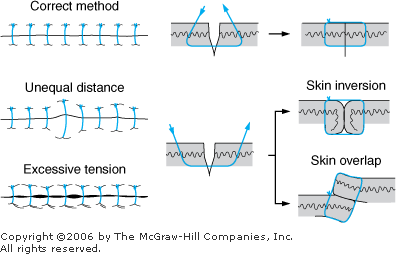 | Proper method for simple interrupted suturing of a skin wound compared with incorrect techniques that result in poor scars from skin overlap, skin inversion, or necrosis of the skin edges due to excessive tension. |
|
| 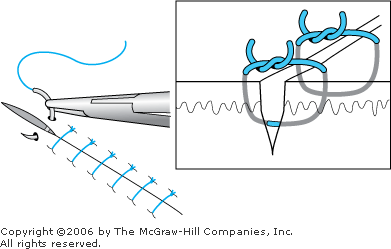 | Simple interrupted sutures. "Bites" are taken through the thickness of the skin, and the width of each stitch should equal the distance between sutures to avoid inverting the skin edges. |
|
| 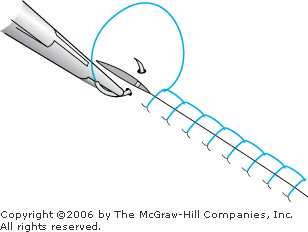 | Continuous running suture. Technique allows rapid closure but depends on only two knots for security and may not allow precise approximation of the skin edges. "Locking" each stitch, as shown, may increase scarring. |
|
| 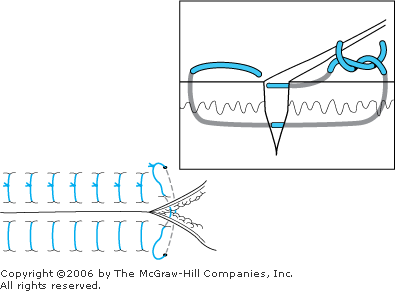 | Vertical interrupted mattress sutures. Technique allows precise approximation of skin edges with little tension but can result in more scarring than simple stitches. Needle is placed in the skin in a "far, far, near, near" sequence. |
|
|  | Horizontal interrupted mattress sutures. This everting stitch is more frequently used in fascia than in skin. It is often used in calloused skin, such as the palms and soles. |
|
| 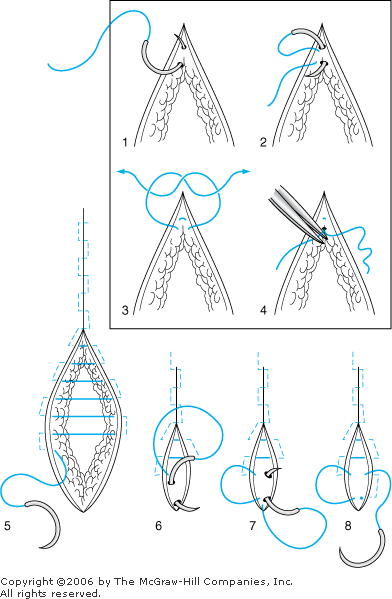 | Subcuticular closure is usually performed with continuous, horizontally applied intradermal sutures. These sutures are ideal for linear cosmetic closure because they eliminate possible cross-hatching deformities. If nonabsorbable suture material (eg, 5-0 or 6-0 Prolene) is used, the knot is placed on the skin and pulled taut. If absorbable (5-0 or 6-0 Dexon or Vicryl) is used, the knot is usually buried as shown. The knot is tied in part 8, the needle passed through the skin, and the suture material cut flush. |
|
|
Surgical Knots There are three basic knot-tying techniques: one-handed and two-handed ties and the instrument tie. The most advanced knot-tying technique is a one-handed tie, not recommended for medical students or junior residents. Although one-handed ties can be more useful in certain situations (eg, deep cavities or need for speed), the two-handed tie is easier to learn. Instrument ties are more useful for closing skin and for emergency department laceration repair. Figure 17 7 shows the technique for tying a two-handed square knot, the standard surgical knot that should be learned first. Figure 17 8 shows the technique for a one-handed tie. Figure 17 9 shows the technique for an instrument tie. | 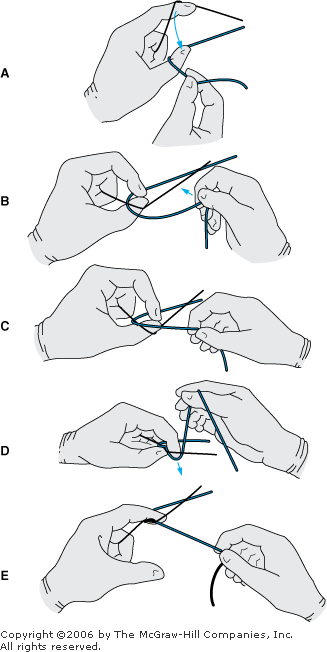 | 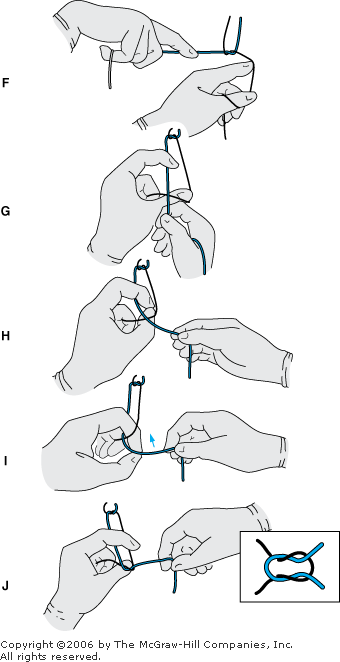 | Technique for tying two-handed square knot. Suture ends are uncrossed as step A begins. Hands must be crossed at the end of the first loop tie (step F) to give a flat knot; hands are not crossed at the end of the second loop tie (step J). |
|
| 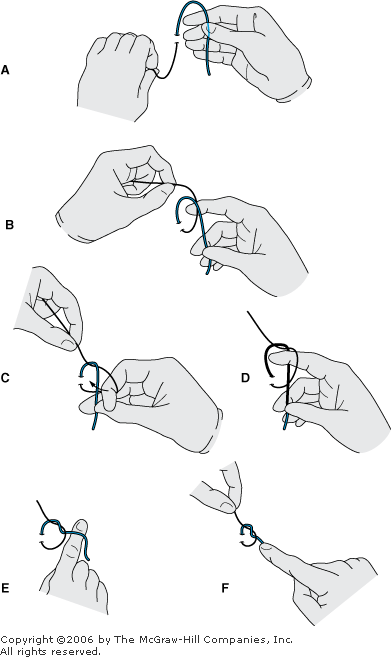 | 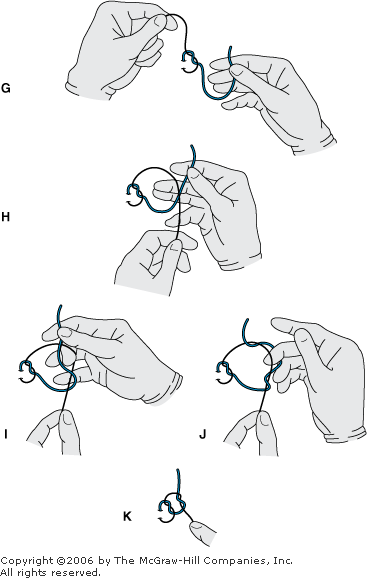 | One-handed tie. The right hand sets up the loop and manipulates the working strand. |
|
|  | The instrument tie. Begin with either a single or double (illustrated) looping of the lower end of the suture around the needle holder. The first loop is laid flat without crossing the hands. Hands must be crossed after the second loop tie (step G) to produce a flat square knot. |
|
|
Suture Removal The longer a permanent suture material is left in place in the skin, the more scarring it produces. Using a topical antibiotic ointment (eg, Polysporin) on the wound is helpful in decreasing suture tract epithelialization. Epithelialization results from crusting around the suture that increases suture marks and subsequent scarring. Sutures can be safely removed when a wound has developed sufficient tensile strength. Situations vary greatly, but general guidelines for removing sutures from different areas of the body are as follows: face and neck, 3 5 d; scalp and body, 5 7 d; extremities, 7 12 d. Any suture material or skin clips can be removed earlier if they have been reinforced with a deep absorbable suture or with application of Steri-Strips after the suture is removed. Steri-Strips stay in place more securely if tincture of benzoin (spray or solution) is applied to the skin and allowed to dry before the Steri-Strips are applied. The length of time absorbable sutures remain in tissues is shown in Table 17 1. Suture Removal Procedure | | 1. Gently clear away any dried blood with saline solution and gauze. Verify that the wound is sufficiently healed to allow suture removal. Use a forceps to gently elevate the knot off the skin. This step can be uncomfortable for the patient. |
| | 2. Cut the suture as close to the skin as possible so that a minimal amount of "dirty suture" is dragged through the wound. When removing continuous sutures, cut and pull out each section individually. Never pull a knot through the skin. Often the suture material is pulled tight to the skin, and it is difficult to remove the stitch with thick scissors. A no. 11 scalpel with the blade pointed up is helpful in this situation. |
| | 3. Use of skin staples is commonplace in the OR because of the rapidity of closure and the nonreactive nature of the steel staples. Staples are typically removed 3 5 d after surgery (abdominal incisions) as shown in Figure 17 10. Because staples are removed fairly quickly, reinforce the incision with Steri-Strips and benzoin. When removing skin staples, make sure that the staple is completely reformed (see Figure 17 10) before pulling it out of the skin to decrease patient discomfort. Before removal, verify that the wound is epithelialized and that there is no sign of infection or wound leakage. If the wound gaps or if a discharge appears as the staples are removed, stop the removal procedure and ask a senior physician to evaluate the wound. |
| 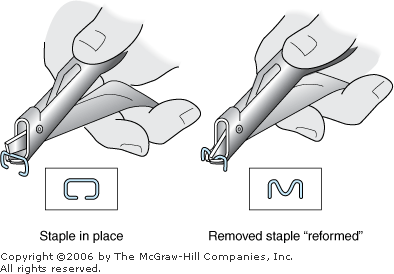 | Removal of skin staples. The staple remover is passed beneath the staple and completely closed. To decrease patient discomfort, be sure that the staple is completely "reformed" before removal. (Courtesy of Ethicon, Inc.) |
|
|
Tissue Adhesives Octyl cyanoacrylate (Dermabond) and n-butyl-2-cyanoacrylate (Indermil) are topical skin adhesives similar to cyanoacrylate glue that hold wound edges together. These substances are useful in closure of topical skin incisions and lacerations in areas of low skin tension that are simple, thoroughly cleansed, and have easily approximated skin edges. Adhesives can be used in conjunction with, but not in place of, deep dermal stitches. They are particularly useful in treatment of young children, for whom suture removal may be a problem. The wound should be nonmucosal on the face, torso, or extremity. Adhesives are recommended for wounds < 8 cm with minimal tension (skin gap < 0.5 cm) and for stabilizing wounds after early suture removal to minimize suture marks. Do not use tissue adhesives for puncture wounds, bites, or wounds that need debridement or in anatomic regions subjected to frequent movement (eg, joints). The patient may shower for brief periods with this type of closure. | | 1. Gently approximate the wound edges with fingers or a forceps and place a small coating of the glue directly on the wound. Dermabond has a direct-contact applicator tip; Indermil has a noncontact applicator tip. |
| | 2. Wait 2 3 min for the glue to dry, and apply an additional one or two coats if needed. The glue sheds in 5 10 d. |
| | 3. Once the glue is in place and stable, it is not necessary to use topical medication or ointment. If the adhesive remains tacky, too much glue has been applied. |
|
| |  |